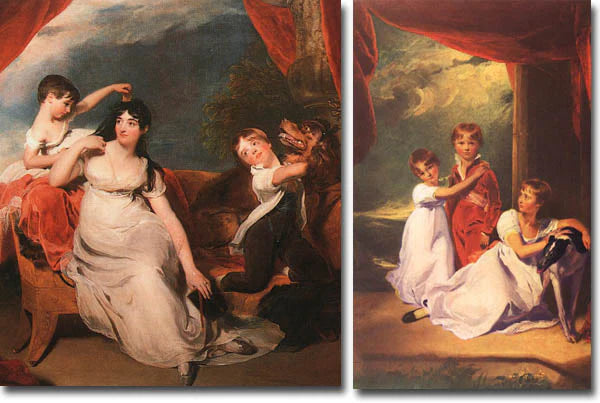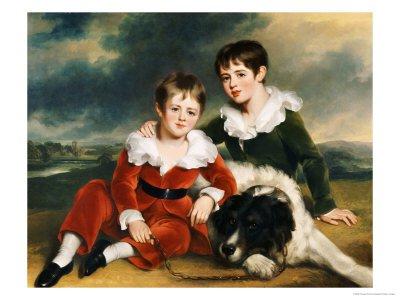Regency Children's Clothing: Daywear and Playwear
Boys

The boy's costume here is known as a "Skeleton Suit" which would have been worn up to age 8 or 9, after which he might be put, a the beginning of the period, into breeches and waistcoat, with a relaxed long jacket. Later in the period, the boy of this age would wear a short, tailless jacket and long trousers, [the Eton suit], and this style continued throughout the 19th century and beyond. Boys were put into the skeleton suit at about 3 or 4 years old; before this they wore a frock, which sometimes makes for difficulty in distinguishing them from theirs sisters in portraits. The skeleton suit was usually made of heavy cotton or linen, which were both practical washing fabrics. Blue was a favorite colour, but examples in pea-green and occasionally scarlet or mustard are also documented. Charles Dickens described, in 1838, some time after they ceased to be worn, "A skeleton suit, one of those straight blue cloth cases in which small boys used to be confined in ingenious contrivance for displaying the symmetry of a boys figure by fastening him into a very tight jacket and then buttoning his trousers over it so as to give his legs the appearance of being hooked just under the armpits."
The shirt, with frilled collar, was always worn with this suit and was made of fine cotton or linen.
Girls
The girl's gown is made from white cotton muslin, the perennial favorite of this period, although it was more likely to be worn for best or in the afternoon. Printed cottons, or more practical fabrics, would be worn in the morning, and a "slip" of colored silk might be worn under the white muslin for special evening wear. Sometimes, girls wore stays under these soft gowns, but they were very light and were intended to correct posture, not to constrict the figure.

Under her dress she might have had a slim petticoat, but by the start of the nineteenth century drawers or pantaloons were taking their place. The model shown is wearing a pair of cotton lawn pantaloons, frilled with voile at the legs, attached to a small bodice. They are buttoned down the back and open between the legs, only being joined at the front. Very practical! The silk sash was an indispensable part of this look; smart young girls had many sashes, of all colours; when the young Fanny Price arrives at Mansfield Park with only two sashes, her modish cousins "could not but hold her cheap." Dress your own Regency fashion girl, click here for our range of children's dress patterns and paper dolls! Costume researched, designed and constructed by Yvonne Roe, Gloucester. Special to the Jane Austen Centre, Bath.



Leave a comment
This site is protected by hCaptcha and the hCaptcha Privacy Policy and Terms of Service apply.